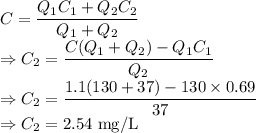
Chemistry, 06.04.2021 03:20 animationfusion
A city continuously disposes of effluent from a wastewater treatment plant into a river. The minimum flow in the river is 130 m3/s, and the discharge from the treatment plant is 37 m3/s. Upstream from the outfall, the background concentration is 0.69 mg/L. The maximum allowable concentration in the river is 1.1 mg/L. What is the maximum concentration that of the pollutant (in mg/L) that can be safely discharged from the wastewater treatment plant

Answers: 1
Another question on Chemistry

Chemistry, 21.06.2019 14:10
Can smoke be transformed into liquid or used as energy or both?
Answers: 2

Chemistry, 22.06.2019 00:30
This element exists in adundance in the sun.explain how you would go about capturing sunlight.would this captured sunlight contain any of the element?
Answers: 1

Chemistry, 22.06.2019 11:40
Effect of rotenone and antimycin a on electron transfer rotenone, a toxic natural product from plants, strongly inhibits nadh dehydrogenase of insect and fish mitochondria. antimycin a, a toxic antibiotic, strongly inhibits the oxidation of ubiquinol. (a) explain why rotenone ingestion is lethal to some insect and fish species. (b) explain why antimycin a is a poison. (c) given that rotenone and antimycin a are equally effective in blocking their respective sites in the electron-transfer chain, which would be a more potent poison? explain.
Answers: 3

Chemistry, 22.06.2019 19:30
Helium decays to form lithium. which equation correctly describes this decay?
Answers: 2
You know the right answer?
A city continuously disposes of effluent from a wastewater treatment plant into a river. The minimum...
Questions






Health, 09.07.2019 06:00

History, 09.07.2019 06:00

English, 09.07.2019 06:00




Social Studies, 09.07.2019 06:00




Biology, 09.07.2019 06:00


Mathematics, 09.07.2019 06:00



 = Flow rate of river =
= Flow rate of river = 
 = Discharge from plant =
= Discharge from plant = 
 = Background concentration = 0.69 mg/L
= Background concentration = 0.69 mg/L = Maximum concentration that of the pollutant
= Maximum concentration that of the pollutant


